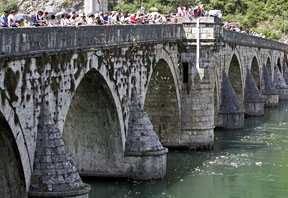The restoration works are galvanising Turkey’s esteem and influence throughout the Balkan region.
By Menekse Tokyay for SES Turkiye in Istanbul — 05/09/12
 The Drina Bridge in BiH was one of the structures that was restored. [Reuters] The Drina Bridge in BiH was one of the structures that was restored. [Reuters]
|
Turkey has been taking a multidimensional foreign policy approach in the Balkan region, with one of its focuses on the preservation of history.
The Turkish International Co-operation and Development Agency (TIKA) has been conducting important restoration projects throughout the Balkan countries, which were under Ottoman rule from the 15th to the 19th century, to preserve cultural and historical heritage.
During the Ottoman reign, 15,787 structures were built, including tombs, mosques, medreses, hamams (Turkish baths), bridges and fountains. However, due to the wars in the region, most of them have been seriously damaged.
András Riedlmayer, an art documentation specialist at Harvard University, said that the Ottoman heritage of the Balkans is the common heritage of all the Balkan peoples, and the preservation of it is something that concerns not only ethnic Turks or the Republic of Turkey.
“Turkey is the largest and most prosperous of the successor states of the Ottoman Empire in Southeast Europe. As such, Turkey is to be commended for assisting in the preservation of this long-neglected Ottoman, and European, heritage,” he told SETimes, adding that cultural diplomacy can contribute to the building of good neighborly relations and has other potential long-term benefits.
The restoration works have been inevitably galvanising Turkey’s esteem and influence over the host countries. According to the experts, the presence of Turkey’s footprint in each Balkan country under the restoration of historical monuments and other artifacts shows once again the deeply-rooted bonds between Turkey and the Balkan geography, as well as a common historical memory.
While in Albania, the restoration of the Parruce Mosque gave the Muslim community a place for daily prayers. In BiH, the restoration of the Drina Bridge served as the preservation of a bridge on UNESCO’s world heritage list through a protocol signed between TIKA and Visegrad Municipality. Accordingly, TIKA restored a number of Ottoman mosques in Macedonia.
In Kosovo, where there are a considerable proportion of ethnic Turks, TIKA has been focusing on the protection of cultural heritage in collaboration of the country’s Culture, Youth and Sport Ministry and Kosovo Islamic Community.
Since 2004, when it was established in Kosovo, TIKA realised the restoration, reparation and maintenance of seven buildings throughout the country, ranging from mosques to the building of the peripheral wall of the Ottoman cemetery, which accommodates important tombs of sheikhs of Ottoman times.
“As the other countries in the Balkans, there is a significant number of historical artifacts remaining from the Ottoman times,” Adem Urfa, coordinator of TIKA Pristine Programme, told SETimes. “Unfortunately these artifacts couldn’t be preserved adequately up to now due to the indifference and economic insufficiencies. So, our aim is to support those buildings which are in fact a common heritage of all humanity.”
To ensure the sustainability of its initiatives, TIKA has been also conducting educational programmes in order to raise the capacity of Kosovan authorities over the protection of cultural heritage as well as the exchange of field experiences.
Last month, Turkey’s Deputy Prime Minister Bekir Bozdag paid a visit to Kosovo to declare the upcoming projects’ timetable.
“We are planning to realise five projects [in 2012-2013], with 3.7 million euros,” Urfa told SETimes, adding that the projects involve the restoration of Ottoman mosques, hamams and landscape planning in Pristina, Prizren, Janjeva and Vushtrria.
The preservation of Ottoman heritage in the Balkans, and mosques in particular, also means the protection of the Muslim population in the region.
Isuf Gashi, 69, from Pristina, prays daily at the mosques. “For a long time mosques only witnessed destruction, making an uncomfortable place to visit and to practice religious beliefs. It was necessary to finally restore them, and I’m very pleased,” Gashi told SETimes.
The restoration projects carried out by TIKA have been also contributing to increase those countries’ attractiveness both in cultural and historical terms, while significantly contributing to the national economy by the means of cultural tourism. “For instance, Sultan Murat tomb, which was restored and maintained by TIKA, attracted almost 10,000 tourists just in 2011, having a real contribution to the urban economy,” Urfa said. Shasivar Haxhijaj, senior advisor to the Kosovo minister for Culture, Youth and Sports, told SETimes that the preservation of cultural heritage is one of the top priorities for the ministry to boost the tourism pillar.
“Thus we have a number of important international partners supporting our efforts in this area, such as TIKA, the Council of Europe, western embassies,” Haxhijaj said.
Related Articles
04/01/2012
02/03/2012
21/07/2012
26/03/2012
24/04/2012
In Romania, with whom Turkey has 134 years of history, the repair and restoration works of Turkish-Islamic monuments are conducted in partnership with state institutions, Turkish businessmen and the local community. The significant proportion of country’s mosques and tombs needs urgent restoration, experts say.
However, an expression of interest and generosity does not confer entitlement, Riedlmayer said, adding that the best way to build good relations is to demonstrate respect for the real owners of this precious heritage: the peoples of the Balkan countries.
“Donor countries and their aid agencies must resist the temptation to assert ‘ownership’ over the restoration projects and monuments that they sponsor. Technical and financial assistance has to be accompanied by respect for local laws and regulations and cooperation with the local preservation authorities in the Balkan countries.”
SETimes correspondents Gabriel Petrescu in Bucharest and Safet Kabashaj in Pristina contributed to this report.

Leave a Reply